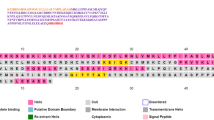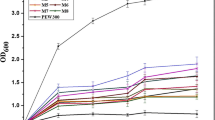Abstract
Antimicrobial peptides will be attractive and potential candidates as peptide drugs because of their efficient action against microbes and low toxicity to mammal cells. To improve their antibacterial activity, some modifications needs to be made. In this research, the hybrid peptide gene Attacin-Thanatin with 642 bp in length with preferred codons of E. coli was generated using the technology of Gene splicing by overlap extension. The gene was inserted in-frame into E. coli expression plasmid pET-32a (+) and induced to express in E. coli Rosetta. The recombinant protein was partial purified and its biological activity was determined. Analysis of the E. coli Rosetta induced with IPTG revealed that the molecular weight of fusion protein was approximately 41.8 kDa, which perfectly matched the mass calculated from the amino acid sequence. Biological activity detection showed that this peptide effectively inhibited the growth of the test bacteria including E. coli DH5α, E. coli BL21 (DE3), Salmonella choleraesuis and Staphylococcus aureus. Among these bacteria, the Gram-negative E. coli was the most sensitive. Furthermore, there was minor hemolysis activity for porcine red blood cells. So, the results indicated that the hybrid peptide Attacin-Thanatin could be served as a promising candidate for the chemical antibiotics.



Similar content being viewed by others
References
Brogden KA (2005) Antimicrobial peptides: pore formers or metabolic inhibitors in bacteria? Nat Rev Microbiol 3:238–250
Sood R, Domanov Y, Kinnunen PKJ (2007) Fluorescent temporin B derivative and its binding to liposomes. J Fluoresc 17:223–234
Hultmark D, Engström A, Andersson K, Steiner H, Bennich H, Boman HG (1983) Insect immunity: attacins, a family of antibacterial proteins from Hyalophora cecropia. EMBO 2:571–576
Carlsson A, Engström P, Palva ET, Bennich H (1991) Attacin, an antibacterial protein from Hyalophora cecropia, inhibits synthesis of outer membrane proteins in Escherichia coli by interfering with omp gene transcription. Infect Immun 59:3040–3045
Sun SC, Lindström I, Lee JY, Faye I (1991) Structure and expression of the attacin genes in Hyalophora cecropia. Eur J Biochem 196:247–254
Geng H, An CJ, Hao YJ, Li DS, Du RQ (2004) Molecular Cloning and Expression of Attacin from Housefly (Musca domestica). Acta Genet Sin 31:1344–1350
Sugiyama M, uniyoshi HK, Kotani E, Taniai K, Kadono-Okuda K, Kato Y, Yamamoto M, Shimabukuro M, Chowdhury S, Xu J, Choi SK, Kataoka H, Suzuki A, Yamakawa M (1995) Characterization of a Bombyx mori cDNA encoding a novel member of the attacin family of insect antibacterial proteins. Insect Biochem Mol Biol 25:385–392
Zhang B, Wang LM, Ye B, Li SY, Zhao ZJ, Fan Q (2006) Cloning and analysis of cDNA of the attacin gene from the Chinese oak silkworm, Antheraea pernyi, using RLM-RACE method. Canye Kexue 32:333–339
Hu YJ, Aksoy S (2002) In vitro expression of tsetse attacin and its activity against Trypanosoma brucei. Am J Trop Med Hyg 67:371
Xu JH, Zhu JY, Jin XB, Xu QY (2007) Cloning and expression of antibacterial peptide Attacin gene isolated from Musca Domestica Larvae and its biological activities. J Med Mol Biol 4:20–26
Carlsson A, Nyström T, Cock DH, Bennich H (1998) Attacin-an insect immune protein-binds LPS and triggers the specific inhibition of bacterial outer-membrane synthesis. Microbiol 144:2179–2188
Fehlbaum P, Bulet P, Chernysh S, Briand JP, Roussel JP, Letellier L, Hetru C, Hoffmann JA (1996) Structure-activity analysis of thanatin, a 21-residue inducible insect defense peptide with sequence homology to frog skin antimicrobial peptides. Proc Natl Acad Sci USA 93:1221–1225
Andreu D, Ubach J, Boman A, Wåhlin B, Wade D, Merrifield RB, Boman HG (1992) Shortened cecropin A-mellitin hybrids. Significant size reduction retains potent antibiotic activity. FEBS Lett 296:190–194
Saugar JM, Alarcón T, López-Hernandez S, López-Brea M, Andreu D, Rivas L (2002) Activity of polymyxin B and cecropin A-melittin peptide CA (1–8) M (1–18) against a multireistant strain of Acinetobacter baumannii. Antimicrob Agents Chemother 46:875–878
Oh H, Hedberg M, Wade D, Edlund C (2000) Activities of synthetic hybrid peptides against anaerobic bacteria: aspects methodology and stability. Antimicrob Agents Chemother 44:68–72
Ho S, Horton R, Hunt H (1989) Site-directed mutagenesis by overlap extension using the polymerase chain reaction. Gene 77:51–59
Horton R, Hunt H, Ho S (1989) Engineering hybrid genes without the use of restriction enzymes: gene splicing by overlap extension. Gene 77:61–68
Wingfield PT. (2005) Preparation of soluble proteins from Escherichia coli. Curr Protoc Protein Sci. Chapter 6 Unit 6. 2
Lehrer RI, Rosenman M, Harwig SS, Jackson R, Eisenhauer P (1991) Ultrasensitive assays for endogenous antimicrobial polypeptides. J Immunol Methods 137:167–173
Wu M, Hancock RE (1999) Interaction of the cyclic antimicrobial cationic peptide bactenecin with the outer and cytoplasmic membrane. J Biol Chem 274:28–35
Bignami GS (1993) A rapid and sensitive hemolysis neutralization assay for palytoxin. Toxicon 31:817–820
Kishimoto K, Fujimoto S, Matsumoto K et al (2002) Protein purification, cDNA cloning and gene expression of attacin, an antibacterial protein, from eri-silkworm, Samia cynthia ricini. Insect Biochem Mol Biol 32:881–887
Mukhija R, Rupa P, Pillai D, Garg LC (1995) High level production and single purification of biologically active human growth hormone in E. coli. Gene 165:303–306
Arnau J, Lauritzen C, Petersen GE, Pedersen J (2006) Current strategies for the use of affinity tags and tag removal for the purification of recombinant proteins. Protein Expr Purif 48:1–13
Porath J (1992) Immobilized metal ion affinity chromatography. Protein Expr Purif 3:263–281
Skosyrev VS, Kulesskiy EA, Yakhnim AV, Temirov YV, Vinokurov LM (2003) Expression of the recombinant antibacterial peptide sarcotoxin IA in Eschericha coli cells. Protein Expr Purif 28:350–356
Liang Y, Wang JX, Zhao XF, Du XJ, Xue JF (2006) Molecular cloning and characterization of cecropin from the housefly (Musca domestica), and its expression in Escherichia coli. Dev Comp Immunol 30:249–257
Lee MK, Cha LN, Lee SH, Hahm KS (2002) Role of amino acid residues within the disulfide loop of Thanatin, a potent antibiotic peptide. J Biochem Mol Biol 35:291–296
Lee DG, Kim PI, Park Y, Woo E-R, Choi JS, Choi C-H et al (2002) Design of novel peptide analogs with potent fungicidal activity, based on PMAP-23 antimicrobial peptide isolated from porcine myeloid. Biochem Biophys Res Commun 29:231–238
Giacometti A, Cirioni O, Kamysz W, D’Amato G, Silvestri C, Prete MSD et al (2004) In vitro activity and killing effect of the synthetic hybrid cecropin A-melittin peptide CA(1–7)M(2–9)NH2 on methicillin-resistant nosocomial isolates of Staphylococcus aureus and interactions with clinically used antibiotics. Diagn Microb Infect Dis 49:197–200
Giacometti A, Cirioni O, Kamysz W, D’Amato G, Silvestri C, Prete MSD et al (2003) Comparative activities of cecropin A, melittin, and cecropin A-melittin peptide CA(1–7)M(2–9)NH2 against multidrug-resistant nosocomial isolates of Acinetobacter baumannii. Peptides 24:1315–1318
Acknowledgments
The authors thank Mr. X. F. Liu for providing the agarose beads used for protein purification. Project was funded by grants from Program for Changjiang Scholars and Innovative Research Team in University with grant. No. IRTO 555-5, China Ministry of Education, and Feed Biotechnology Project of Sichuan Province of China with grant No.2007Z06-050.
Author information
Authors and Affiliations
Corresponding author
Rights and permissions
About this article
Cite this article
Wang, L.N., Yu, B., Han, G.Q. et al. Design, expression and characterization of recombinant hybrid peptide Attacin-Thanatin in Escherichia coli . Mol Biol Rep 37, 3495–3501 (2010). https://doi.org/10.1007/s11033-009-9942-3
Received:
Accepted:
Published:
Issue Date:
DOI: https://doi.org/10.1007/s11033-009-9942-3




